
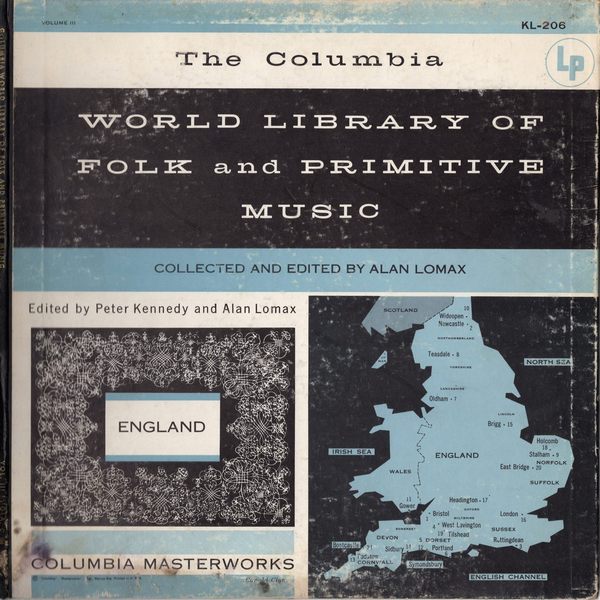 |
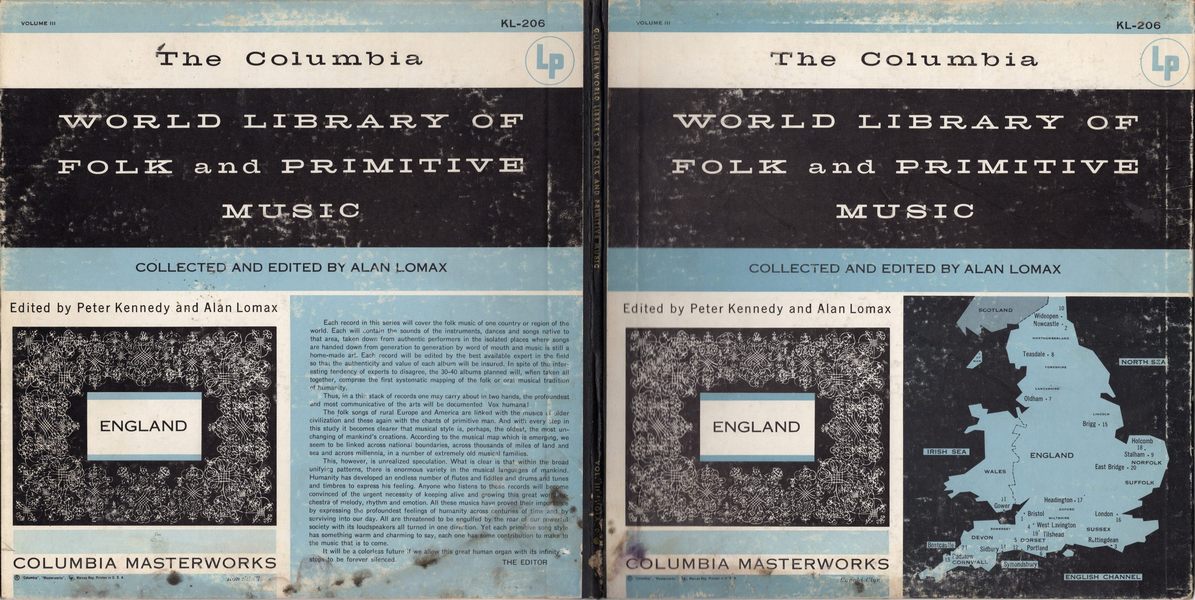
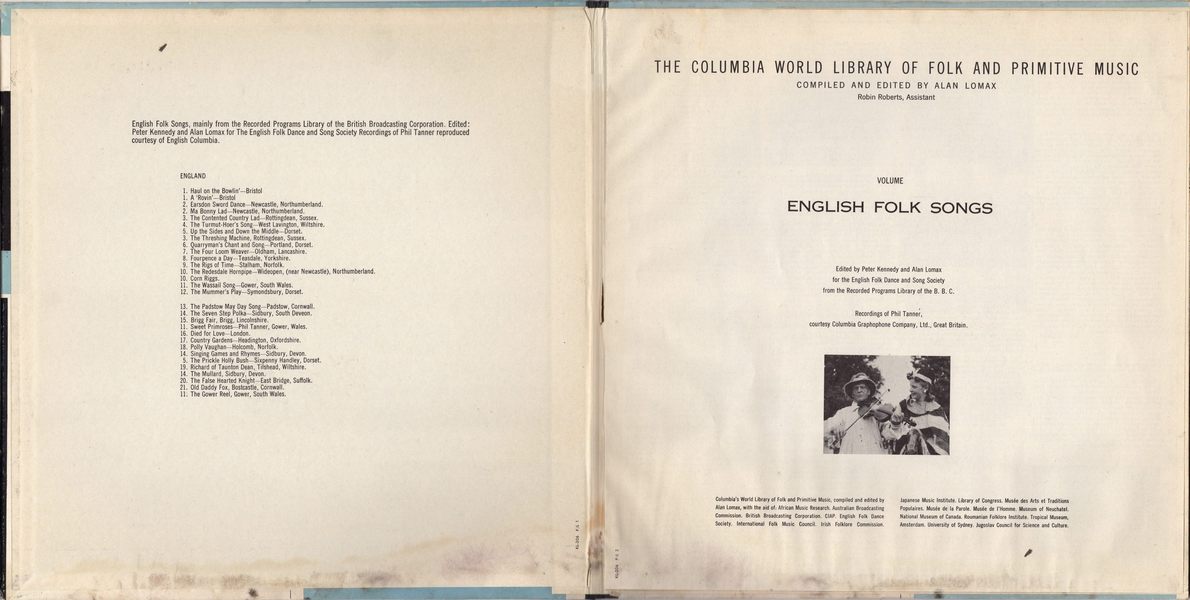 |
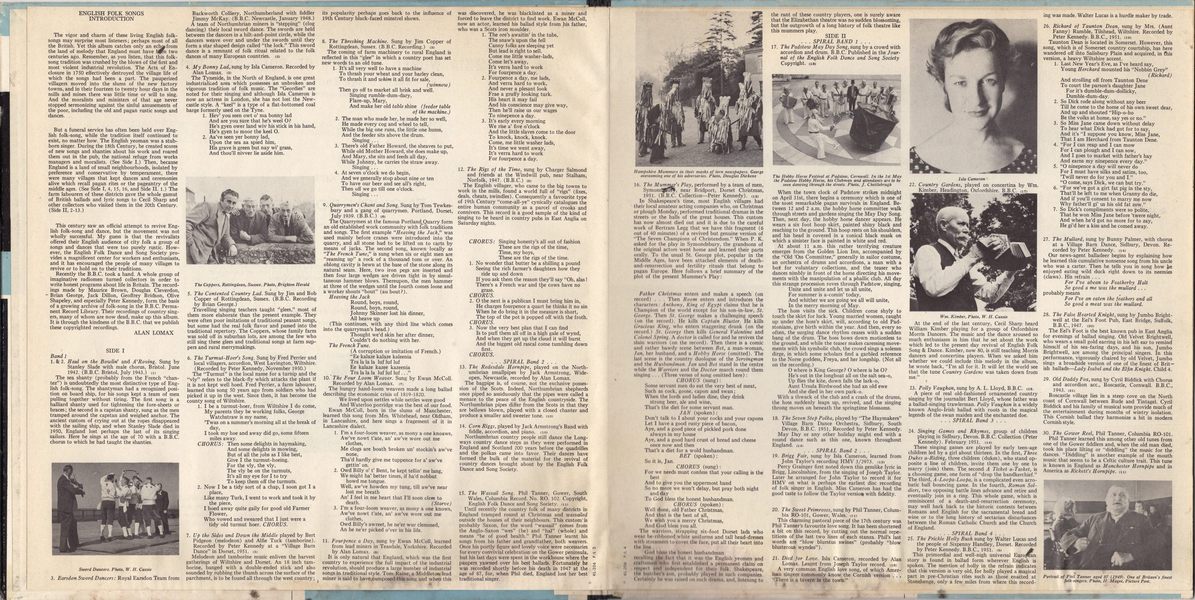
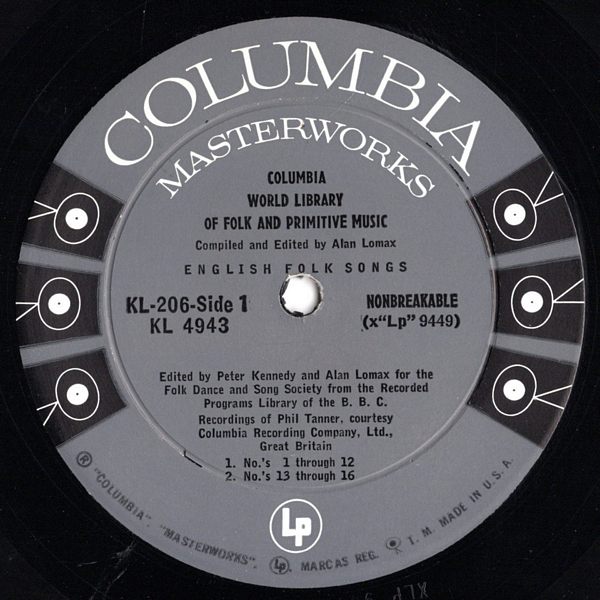
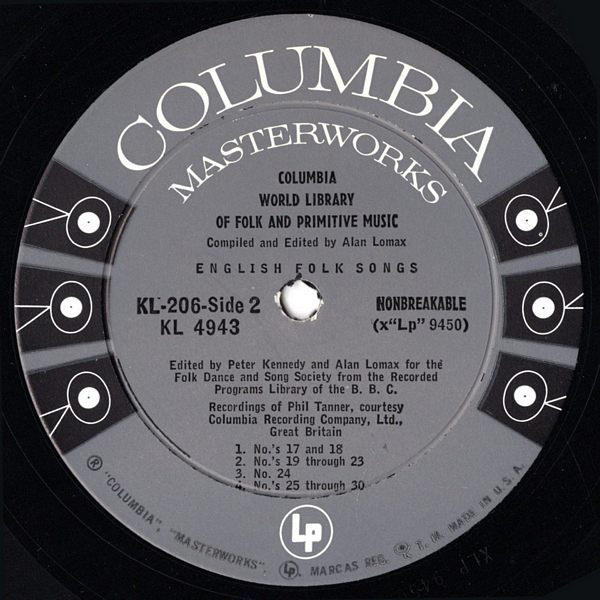 |
English Folk Songs Introduction
The vigor and charm of these living English folksongs may surprise most listeners; perhaps most of all the British. Yet this album catches only an echo from the land of melody that England must have been two centuries ago. Remember, as you listen, that this folksong tradition was crushed by the blows of the first and most violent industrial revolution. The Acts of Enclosure in 1750 effectively destroyed the village life of which the songs had been a part. The pauperized villagers moved into the slums of the new factory towns, and in their fourteen to twenty hour days in the mills and mines there was little time or will to sing. And the moralists and ministers of that age never stopped sermonizing against the sinful amusements of the poor, including the old and pagan rustic songs and dances.
But a funeral service has often been held over English folk-song, while the tradition itself continued to exist, no matter how. The English yeoman was a stubborn singer. During the 18th Century, he created scores of new songs and shanties about his work and roared them out in the pub, the national refuge from works managers and moralists. (See Side I.) Then, because England is a land of small neighbourhoods, isolated by preference and conservative by temperament, there were many villages that kept dances and ceremonies alive which recall pagan rites or the pageantry of the middle ages. (See Side I, 4, 15, 16, and Side II. 1.) The farm labourers of these districts gave the whole gamut of British ballads and lyric songs to Cecil Sharp and other collectors who visited them in the 20th Century. (Side II, 2-13.)
This century saw an official attempt to revive English folk-song and dance, but the movement was not wholly successful. My guess is that the revivalists offered their English audience of city folk a group of songs and dances that were too purely rustic. However, the English Folk Dance and Song Society provides a magnificent center for workers and enthusiasts, and it has encouraged the people of many villages to revive or to hold on to their traditions.
Recently the B.B.C. took a hand. A whole group of imaginative radiomen turned collectors in order to write honest programs about life in Britain. The recordings made by Maurice Brown, Douglas Cleverdon, - Brian George, Jack Dillon, Geoffrey Bridson, Olive Shapeley, and especially Peter Kennedy, form the basis of a growing archive of folk-song in the B.B.C. Permanent Record Library. Their recordings of country singers, many of whom are now dead, make up this album. It is through the kindness of the B.B.C. that we publish these copyrighted recordings.
ALAN LOMAX
Sleeve Notes
1. & 2. Haul on the Bowlin' and A'Roving. Sung by Stanley Slade with male chorus, Bristol. June 1942. (B.B.C. Bristol, July 1943.)
The sea shanty (probably from the French "chantez") is undoubtedly the most distinctive type of English folk-song. The shantyman had a recognized position on board ship, for his songs kept a team of men pulling together without tiring. The first song is a halliard shanty used for tightening the fore-sheets or braces; the second is a capstan shanty, sung as the men tramped around the capstan and weighed anchor. The ancient custom of crying out at the ropes disappeared with the sailing ship, and when Stanley Slade died in 1950, England lost perhaps the last of its singing sailors. Here he sings at the age of 70 with a B.B.C. chorus to which he had taught the shanties.
3. Earsdon Sword Dancers: Royal Earsdon Team from Backworth Colliery, Northumberland with fiddler Jimmy McKay. (B.B.C. Newcastle, January 1948.)
A team of Northumbrian miners is "stepping" (clog dancing) their local sword dance. The swords are held between the dancers in a hilt-and-point circle, while the dancers weave over and under the swords until they form a star shaped design called "the lock." This sword dance is a remnant of folk ritual related to the folk dances of many European countries.
4. My Bonny Lad. Sung by Isla Cameron. Recorded by Alan Lomax.
The Tyneside, in the North of England, is one great industrialized area which possesses an unbroken and vigorous tradition of folk music. The "Geordies" are noted for their singing and although Isla Cameron is now an actress in London, she has not lost the Newcastle style. A "keel" is a type of a flat-bottomed coal barge formerly used on the Tyne.
5. The Contented Country Lad. Sung by Jim and Bob Copper of Rottingdean, Sussex. (B.B.C. Recording by Brian George.)
Travelling singing teachers taught "glees," most of them more elaborate than the present example. They were often poor imitations of traditional peasant songs, but some had the real folk flavor and passed into the traditional repertory. The Coppers, whose family farm was sold off in suburban lots, are among the few who still sing these glees and traditional songs at farm suppers and rural merrymakings.
6. The Turmut-Hoer's Song. Sung by Fred Perrier and local villagers, accordion, West Lavington, Wiltshire. (Recorded by Peter Kennedy, November 1950.)
The "Turmut" is the local name for a turnip and the "vly" refers to the black-fly which attacks the plant if it is not kept well hoed. Fred Perrier, a farm labourer, learned this song 50 years ago from soldiers who had picked it up in the west. Since then, it has become the county song of Wiltshire.
7. Up the Sides and Down the Middle played by Bert Pidgeon (melodeon) and Alfie Tuck (tamborine). Recorded by Peter Kennedy at a "Village Barn Dance" in Dorset, 1951.
Melodeon and tamborine music enliven the harvest gatherings of Wiltshire and Dorset. An 18 inch tamborine, banged with a double-ended stick and also sounded by rubbing the thumb across the surface of the parchment, is to be found all through the west country;
its popularity perhaps goes back to the influence of 19th Century black-faced minstrel shows.
8. The Threshing Machine. Sung by Jim Copper of Rottingdean, Sussex. (B.B.C. Recording.)
The coming of farm machinery to rural England is reflected in this "glee" in which a country poet has set new words to an old tune.
9. Quarrymen's Chant and Song. Sung by Tom Tewkesbury and a gang of quarrymen. Portland, Dorset, July 1939. (B.B.C.)
The Quarrymen at the famous Portland, Quarry form an old established work community with folk traditions and songs. The first example "Heaving the Jack " was used mainly before cranes were introduced into the quarry, and all stone had to be lifted on to carts by means of jacks. The second song, known locally as uThe French Tune," is sung when six or eight men are "reaming up" a rock of a thousand tons or over. An oblong cavity is hewn at the base of the stone along its natural seam. Here, two iron pegs are inserted and then four large wedges are driven tight in by simultaneous hammer blows. Thereupon, the men hammer at three of the wedges until the fourth comes loose and a worker shouts "bout" (au bout?).
10. The Four Loom Weaver. Sung by Ewan McColl. Recorded by Alan Lomax.
The hungry hand-loom weavers made a long ballad describing the economic crisis of 1819-1820.
We lived upon nettles while nettles were good
And Waterloo porridge was the best of our food.
Ewan McColl, born in the slums of Manchester, learned this song from Mrs. Whitehead, near Oldham, in Lancashire, and here sings a fragment of it in Lancashire dialect.
11. Fourpence a Day, sung by Ewan McColl, learned from lead miners in Teasdale, Yorkshire. Recorded by Alan Lomax.
It is only natural that England, which was the first country to experience the full impact of the industrial revolution, should produce a large number of industrial songs in traditional style. Tom Raine, a Middleton lead miner is said to have composed this song and when this
was discovered, he was blacklisted as a miner and forced to leave the district to find work. Ewan McColl, now an actor, learned his ballad style from his father, who was a Scots iron moulder.
12. The Rigs of the Time, sung by Charger Salmond and friends at the Windwill pub, near Stalham, Norfolk, 1947. (B.B.C.)
The English villager, who came to the big towns to work in the mills, found a world full of "rigs" (fixes, deals, cheats, swindles). Consequently a favourite type of 19th Century "come-all-ye" cynically catalogues the entire human community as a parcel of crooks and connivers. This record is a good sample of the kind of singing to be heard in country pubs in East Anglia on Saturday nights.
13. The Redesdale Hornpipe, played on the Northumbrian smallpipes by Jack Armstrong, Wide-open, Newcastle, recorded by Alan Lomax.
The bagpipe is, of course, not the exclusive possession of the Scots. Indeed, Northumbrian shepherds once piped so assiduously that the pipes were called a menace to the peace of the English countryside. The Northumbrian pipes differ from the Scots in that they are bellows blown, played with a closed chanter and produce a smaller and sweeter tone.
14. Corn Riggs, played by Jack Armstrong's Band with fiddle, accordion, and piano.
Northumbrian country people still dance the Longways country dance steps as they were performed in England and Scotland 200 years before the quadrilles and the polkas came into favor. Their dances have formed the bulk of the material for the revival of country dances brought about by the English Folk Dance and Song Society.
15. The Wassail Song. Phil Tanner, Gower, South Wales, Columbia Record. No. RO. 102. Copyright, English Folk Dance and Song Society.
Until recently the country folk of many districts in England tramped round at Christmas and wassailed outside the houses of their neighbours. This custom is probably Saxon, for the word "wassail" comes from the Anglo-Saxon "wes" (be) and "hal" (whole) and means "be of good health." Phil Tanner learnt his songs from his father and grandfather, both weavers. Once his portly figure and lovely voice were necessaries for every convivial celebration on the Gower peninsula, but his last days were spent in the workhouse where the paupers yawned over his best ballads. Fortunately he was recorded shortly before his death in 1947 at the age of 87, for, when Phil died, England lost her best traditional singer.
16. The Mummer's Play, performed by a team of men, Symondbury, near Bridport, Dorset Christmas, 1951. (B.B.C. Collection — Peter Kennedy).
In Shakespeare's time, most English villages had their local amateur acting companies who, on Christmas or plough Monday, performed traditional dramas in the streets or the halls of the great houses. This custom has now almost died out and it is due to the careful work of Bertram Legg that we have this fragment (6 out of 40 minutes) of a revived but genuine version of "The Seven Champions of Christendom." When P. K. asked for the play in Symondsbury, the grandsons of the original actors went home and learned their parts orally. To the usual St. George plot, popular in the Middle Ages, have been attached elements of death-and-resurrcction and fertility rituals that belong to pagan Europe. Here follows a brief summary of the plot of the present Mummer's Play:
Father Christmas enters and makes a speech (on record) … Then Room enters and introduces the characters: Anthony, King of Egypt claims that he is Champion of the world except for his son-in-law, St. George. Then St. George makes a challenging speech (on the record), He kills Captain Bluster. He kills Gracious King, who enters staggering drunk (on the record.) St. George then kills General Valentine and Colonel Spring. A doctor is called for and he revives the slain warriors (on the record). Then there is a comic and rather bawdy scene between Bet, a man-woman, Jan, her husband, and a Hobby Horse (omitted). The last scene is the country duologue of the Servingman and the Husbandman. Jan and Bet stand in the centre while the Warriors and the Doctor marcharound them singing …
The warriors, strapping six-foot Dorset lads who wear be-ribboned white uniforms and tall head-dresses with streamers to cover the face, put all their heart into the line …
God bless the honest husbandman recalling the fact that it was the English yeomen and craftsmen who first established a permanent claim on respect and independent for their folk. Shakespeare, the butcher's son, probably played in such companies. Certainly he was raised on such drama, and, listening to the rant of these country players, one is surely aware that the Elizabethan theatre was no sudden blossoming, but the outgrowth of a long history of folk theatre like this mummers play.
17. The Padstow May Day Song, sung by a crowd with accordion and drum. B.B.C. Published in the Journal of the English Folk Dance and Song Society Copyright.
When the town clock of Padstow strikes midnight on April 31st, there begins a ceremony which is one of the most remarkable pagan survivals in England. Between 12 and 2 a.m. the hobby horse committee walk through streets and gardens singing the May Day Song. Then, next day, the hobby horse dancer appears. He wears a six foot hoop skirt, painted shiny black and reaching to the ground. This hoop rests on his shoulders, and his head is covered in a conical black mask on which a sinister face is painted in white and red.
At about 11 a.m. this rather terrifying creature emerges from the Golden Lion Inn, accompanied by the "Old 'Oss Committee," generally in sailor costume, an orchestra of drums and accordions, a man with a box for voluntary collections, and the teaser who dances nimbly in front of the horse directing his movements with the manipulation of a phallic club. All day this strange procession roves through Padstow, singing,
Unite and unite and let us all unite,
For summer is a-comin' today,
And whither we are going we all will unite,
In the merry morning of May.
The hoss visits the sick. Children come shyly to touch the skirt for luck. Young married women, caught up under the hoss's skirt, will, according to old Padstonians, give birth within the year. And then, every so often, the surging dance rhythm ceases with a sudden bang of the drum. The hoss bows down motionless to the ground, and while the teaser makes caressing movements with his symbolic club, the crowd sings a solemn dirge, in which some scholars find a garbled reference to the Norse goddess, Freya, and her longship. (Not all on the recording.)
O where is King George? O where is he O?
He's out in the longboat all on the salt sea-o,
Up flies the kite, down falls the lark-o,
Aunt Ursula Birdwood she had an old ewe
And she died in her own park-o.
With a thwack of the club and a crash of the drums, the hoss suddenly leaps up, revived, and the singing throng moves on beneath the springtime blossoms.
18. The Seven Step Polka, played by "The Haymakers" Village Barn Dance Orchestra, Sidbury, South Devon, B.B.C. 1951, Recorded by Peter Kennedy.
May Day or any other holiday might end with a round dance such as this one, known throughout England.
19. Brigg Fair, sung by Isla Cameron, learned from John Taylor's recording HMV 3/2973.
Percy Grainger first noted down this gemlike lyric in Brigg, Lincolnshire, from the singing of Joseph Taylor. Later he arranged for John Taylor to record it for HMV on what is perhaps the earliest disc recording of folk singer in English. Miss Cameron has had the good taste to follow the Taylor version with fidelity.
20. The Sweet Primroses, sung by Phil Tanner, Columbia RO-101, Gower, Wales.
This charming pastoral piece of the 17th century was Phil Tanner's favourite love song. It has been shortened a bit on this record, by cutting out the normal repetitions of the last two lines of each stanza. Phil's last words are "blow blurstus swines" (probably "blow blusterous wyndes").
21. Died for Love. Isla Cameron, recorded by Alan Lomax. Learnt from Joseph Taylor record.
A very common English love song, of which American singers commonly know the Cornish version … "There is a tavern in the town."
22. Country Gardens, played on concertina by Wm. Kimber, Headington, Oxfordshire. B.B.C.
At the end of the last century, Cecil Sharp heard William Kimber playing for a group of Oxfordshire Morris Dancers. The music and the dance aroused so much enthusiasm in him that he set about the work which led to the present day revival of English Folk Song & Dance. Kimber, now 80, is still teaching Morris dancers and concertina players. When we asked him whether we could include this melody in the album, he wrote back, "I'm all for it. It will let the world see that the tune Country Gardens was taken down from me."
23. Polly Vaughan, sung by A. L. Lloyd, B.B.C.
A piece of real old-fashioned ornamented country singing by the journalist Bert Lloyd, whose father was a ballad-singing trawlerman. Polly Vaughan is a widely known Anglo-Irish ballad with roots in the magical legends of the swan maiden and the enchanted doe.
24. Singing Games and Rhymes, group of children playing in Sidbury, Devon. B.B.C. Collection (Peter Kennedy). February 1951.
These singing games are played by early teen-age children led by a girl about thirteen. In the first, Three Dukes a-Riding, three children (dukes), who stand opposite a line of children, invite them one by one to marry (join) them. The second A Tisket a-Tasket, is a choosing game, one form of "drop the handkerchief." The third, A-Loopa-Loopa, is a complicated even acrobatic ball bouncing game. In the fourth, Roman Soldiers, two opposing battle lines advance and retire and eventually join in a ring. This whole game, which is reminiscent of a death-and-resurrection ceremony, may well hark back to the historic contests between Romans and English for the sacramental bread and wine or to the long history of sectarian disturbances between the Roman Catholic Church and the Church of England.
25. The Prickle Holly Bush sung by Walter Lucas and the people of Sixpenny Handley, Dorset. Recorded by Peter Kennedy. B.B.C., 1951.
This primordial and well-nigh universal European story is found in ballad form wherever English is spoken. The mention of holly in the refrain indicates that this version is very old, for holly played a magical part in pre-Christian rites such as those enacted at Stonehenge, only a few miles from where this recording was made. Walter Lucas is a hurdle maker by trade.
26. Richard of Taunton Dean, sung by Mrs. (Aunt Fanny) Rumble, Tilshead, Wiltshire. Recorded by Peter Kennedy. B.B.C., 1951.
Taunton Dean is located in Somerset. However, this song, which is of Somerset country courtship, has here wandered off into Salisbury Plain and acquired, in this version, a heavy Wiltshire accent.
27. The Mullard, sung by Bunny Palmer, with chorus at a Village Barn Dance, Sidbury, Devon. Recorded by Peter Kennedy.
Our news-agent balladeer begins by explaining how he learned this cumulative nonsense song from his uncle who was a carter. Then he tells you in song how he enjoyed eating wild duck right down to its neemies (claws).
28. The False Hearted Knight, sung by Jumbo Bright-well at the Eel's Foot Pub, East Bridge, Suffolk, B.B.C., 1947.
The Eel's Foot is the best known pub in East Anglia for evenings of ballad singing. Old Velvet Brightwell, who wears a small gold earring in his left ear to remind himself of his sea-faring days, and his son, Jumbo Brightwell, are among the principal singers. In this performance, vigorously chaired by old Velvet, Jumbo sings a broadside version of one of the finest of British ballads — Lady Isabel and the Elfin Knight. Child 4.
29. Old Daddy Fox, sung by Cyril Biddick with Chorus and accordion acc., Boscastle, Cornwall. B.B.C., 1943.
Boscastle village lies in a steep cove on the North coast of Cornwall between Bude and Tintagel. Cyril Biddick and his family of musical sons provide much of the entertainment during months of wintry isolation. This Cornish ballad they harmonize a bit in modern Cornish style.
30. The Gower Reel, Phil Tanner, Columbia RO-101.
Phil Tanner learned this among other old tunes from
one of the Gower fiddlers and, when the old man died, took his place lilting or "diddling" the music for the dances. "Diddling" is another example of the mouth music that seems to be a Celtic culture trait. This tune is known in England as Manchester Hornpipe and in America as Rickett's Hornpipe.